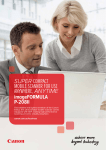Download DR-C130 User Manual
Transcript
Chapter 1 Introduction
Chapter 2 Important Safety
Instructions
Chapter 3 Installing the
Software
Chapter 4 Connecting the
Scanner
Chapter 5 Placing
Documents
Chapter 6 Scanning with
CaptureOnTouch
Chapter 7 Scanning with
CapturePerfect
Chapter 8 Setting the
Scanner Driver
Chapter 9 Special Scanning
Chapter 10 Regular
Maintenance
Chapter 11 Removing and
Attaching the Rollers and
Document Holding Guide
Chapter 12 Uninstalling the
Software
Chapter 13
Troubleshooting
Chapter 14 Appendix
CE-IM-880E1.00
HOME > Chapter 1 Introduction
Chapter 1 Introduction
Thank you for purchasing the Canon imageFORMULA DR-C130
Document Scanner.
In order to fully understand the features of this scanner and use them
more effectively, please read this manual and the manuals shown
below thoroughly before using the product. After reading, store the
manual in a safe place for future reference.
"About This Manual"
"Features of the Scanner"
"Names and Functions of Parts"
"Regulations"
"Trademarks"
HOME > "Chapter 1 Introduction" > About This Manual
About This Manual
Manuals for the Scanner
Documentation for this scanner consists of the following manuals.
● Setup Guide
This provides complete and comprehensive information about
the scanner.
● User Manual (this manual)
This manual contains complete explanations for operations on
the scanner. This manual is stored on the supplied Setup Disc as
a electronic manual.
The User Manual will be registered to the following location in the
start menu after you install the software on the Setup Disc.
Symbols Used in This Manual
The following symbols are used in this manual to explain
procedures, restrictions, handling precautions, and instructions that
should be observed for safety.
Indicates a warning concerning operations that may lead to
death or injury to persons if not performed correctly. To use
the machine safely, always pay attention to these warnings.
Indicates a caution concerning operations that may lead to
injury to persons, or damage to property if not performed
correctly. To use the machine safely, always pay attention to
these cautions.
HOME > "Chapter 1 Introduction" > Features of the Scanner
Features of the Scanner
The main features of the DR-C130 document scanner are
described below.
● Compact Size
The dimensions of the scanner are as follows: 298 mm (W) x
160 mm (H) x 160 mm (W) (11.7" x 6.3" x 6.3") (with the feed
tray and eject tray closed) .
The size of the scanner with the feed tray and eject tray open is
298 mm (W) x 245 mm (H) x 490 mm (W) (11.7" x 9.8" x 19.5").
● Fast Document Feeding
Documents can be scanned at a speed of up to 30 pages per
minute (when scanning one-sided or two-sided documents of A4
size at 200 dpi).
● High Image Quality
The 600 dpi optical resolution sensor incorporated in the scanner
enables documents to be scanned with high image quality.
● Eject Tray
The eject tray enables scanned documents to be stacked. Open
the eject tray when scanning documents that are not output
smoothly. Scanned documents can be output without opening
the eject tray.
● USB 2.0 Interface
The scanner supports Hi-Speed USB 2.0.
● Color/Grayscale Support
Documents can be scanned in 24-bit color or 256-level
grayscale.
● Supports a Variety of Scanning Modes
The scanner supports the following scanning modes, depending
on the document type.
- Simplex and Duplex scanning (with Skip Blank Page function)
- Continuous or single-page feeding
● Card Scan
You can scan business or ID cards.
● Paper Size Detection
The scanner automatically detects the size of a scanned
document and eliminates any unnecessary space around the
edges of the image when storing the image, even when storing a
document of irregular size.
● Auto Color Detection
The scanner detects whether the scanned document is in color,
grayscale, or black and white (binary), and saves the image
accordingly.
HOME > "Chapter 1 Introduction" > Names and Functions of Parts
Names and Functions of Parts
This section describes the name and function of each part.
Make sure to read this section and familiarize yourself with
the parts of the scanner before using the scanner.
Front View/Right-Side View
(1) Document Feed Tray
Open to place documents. -> "Preparing the Document Feed
Tray"
(2) Document Eject Area
Scanned documents are output here.
(3) Stop Button
Press this button to stop scanning before it is complete or to end
panel-feeding.
(4) Start Button
Press this button to start scanning. Its function can be assigned
with CaptureOnTouch.
(5) Power Button
Press this button to turn the scanner ON and OFF.
(6) Power Indicator
This indicator lights blue when the scanner is turned ON.
Front View (With the Document Feed Tray and Eject Tray
Open)
HOME > "Chapter 1 Introduction" > Regulations
Regulations
FCC REGULATIONS (For 120 V model)
Document Scanner, Model M111141
This device complies with Part 15 of the FCC Rules. Operation is
subject to the following two conditions: (1) This device may not
cause harmful interference, and (2) this device must accept any
interference received, including interference that may cause
undesired operation.
Note: This equipment has been tested and found to comply with the
limits for a Class B digital device, pursuant to Part 15 of the FCC
Rules. These limits are designed to provide reasonable protection
against harmful interference in a residential installation. This
equipment generates, uses, and can radiate radio frequency
energy and, if not installed and used in accordance with the
instructions, may cause harmful interference to radio
communications. However, there is no guarantee that interference
will not occur in a particular installation. If this equipment does
cause harmful interference to radio or television reception, which
can be determined by turning the equipment OFF and ON, the user
is encouraged to try to correct the interference by one or more of
the following measures:
● Reorient or relocate the receiving antenna.
● Increase the separation between the equipment and receiver.
● Connect the equipment into an outlet on a circuit different from
that to which the receiver is connected.
● Consult the dealer or an experienced radio/TV technician for
help.
● Use of shielded cable is required to comply with Class B limits in
Subpart B of Part 15 of FCC Rules.
Do not make any changes or modifications to the equipment unless
otherwise specified in the manual. If such changes or modifications
should be made, you could be required to stop operation of the
equipment.
Canon U.S.A. Inc.
One Canon Plaza, Lake Success NY 11042, U.S.A.
Tel. No. (516)328-5000
RADIO INTERFERENCE REGULATIONS (For 120 V models)
This digital apparatus does not exceed the Class B limits for radio
noise emissions from digital apparatus as set out in the
interference-causing equipment standard entitled "Digital
Apparatus", ICES-003 of the Industry Canada.
RÈGLEMENT SUR LE BROUILLAGE RADIOÉLECTRIQUE (For
HOME > "Chapter 1 Introduction" > Trademarks
Trademarks
● Canon and the Canon logo are registered trademarks, of Canon
Inc. in the United States and may also be trademarks or
registered trademarks in other countries.
● imageFORMULA is a trademark of CANON ELECTRONICS INC.
● Microsoft, Windows, Windows Vista, PowerPoint, and SharePoint
are registered trademarks or trademarks of Microsoft Corporation
in the United States and other countries.
● Microsoft product screen shot(s) reprinted with permission from
Microsoft Corporation.
● ENERGY STAR® is a registered trademark of the United States
Environmental Protection Agency.
● ISIS is a registered trademark of Emc Corporation in the United
States.
● Google and Google docs are trademarks of Google Inc.
● Copyright © 1995-2011 Nuance Communications, Inc. All rights
reserved. Nuance, eCopy, OmniPage, and PaperPort are
trademarks
and/or
registered
trademarks
of
Nuance
Communications, Inc. and/or its affiliates in the United States
and/or other countries.
● Adobe, the Adobe logo, Acrobat, the Adobe PDF logo, and Adobe
Reader are either registered trademarks or trademarks of Adobe
Systems Incorporated in the United States and/or other countries.
● Other product and company names herein may be the trademarks
of their respective owners. However, the TM and ® symbols are
not used in this document.
Copyright
Copyright 2012 by CANON ELECTRONICS INC. All rights reserved.
No part of this publication may be reproduced or transmitted in any
form or by any means, electronic or mechanical, including
photocopying and recording, or by any information storage or
retrieval system without the prior written permission of CANON
ELECTRONICS INC.
HOME > Chapter 2 Important Safety Instructions
Chapter 2 Important Safety Instructions
To ensure the safe operation of this scanner, be sure to read the
safety warnings and precautions described below.
"Installation Location"
"AC Adapter"
"Moving the Scanner"
"Handling"
"Disposal"
"When sending the scanner for repairs"
HOME > "Chapter 2 Important Safety Instructions" > Installation
Location
Installation Location
The performance of this scanner is affected by the environment
in which it is installed. Make sure that the location where the
scanner is installed meets the following environmental
requirements.
● Provide adequate space around the scanner for operation,
maintenance, and ventilation.
● Provide adequate space in front of the scanner for documents
output after being scanned.
● Avoid installing the machine in direct sunlight. If this is unavoidable,
use curtains to shade the scanner.
● Avoid locations where a considerable amount of dust accumulates.
● Avoid warm or humid locations, such as in the vicinity of a water
faucet, water heater, or humidifier.
● Avoid locations where ammonia gas is emitted.
● Avoid locations near volatile or flammable materials, such as
alcohol or paint thinner.
● Avoid locations that are subject to vibration.
● Avoid exposing the scanner to rapid changes in temperature. If the
room in which the scanner is installed is cold but rapidly heated,
water droplets (condensation) may form inside the scanner. This
may result in a noticeable degradation in scanning quality.
● The following conditions are recommended for optimal scanning
quality:
- Room temperature: 10 °C to 32.5 °C (50 °F to 90.5 °F)
- Humidity: 20% to 80% RH
● Avoid installing the scanner near equipment that generates a
magnetic field (e.g. speakers, televisions, or radios.)
HOME > "Chapter 2 Important Safety Instructions" > AC Adapter
AC Adapter
● Connect only to a power outlet of the rated voltage and power
supply frequency (120 V, 60 Hz or 220-240 V, 50/60 Hz depending
on your region).
● Do not connect other electrical equipment to the same power outlet
to which the scanner is connected. Also, when using an extension
cord, make sure that the extension cord is rated for the current
requirements of the scanner.
● Never disassemble or modify the AC adapter, as it is dangerous.
● The power cord may become damaged if it is often stepped on or
if heavy objects are placed on it. Continued use of a damaged
power cord and AC adapter can lead to an accident, such as a fire
or electrical shock.
● Do not use the power cord while it is coiled.
● Do not pull directly on the power cord. When disconnecting the
power cord, grasp the plug and remove it from the outlet.
● Keep the area around the power cord clear of objects so that the
power cord can be disconnected easily in an emergency.
● Do not use an AC adapter other than the one provided with the
scanner. Do not use the AC adapter provided with the scanner
with other products.
● If you have any questions regarding the power supply, contact your
local authorized Canon dealer or service representative for further
information.
HOME > "Chapter 2 Important Safety Instructions" > Moving the
Scanner
Moving the Scanner
● When moving the scanner, always hold it with both hands to avoid
dropping it. The scanner weighs approximately 1.8 kg (3.97 lb).
● Make sure to disconnect the interface cable and AC adapter
before moving the scanner. If the scanner is transported with
these items connected, the plugs and connectors may be
damaged.
HOME > "Chapter 2 Important Safety Instructions" > Handling
Handling
Note the following precautions whenever using the scanner.
Failure to do so may result in a fire or electric shock.
■ Never use alcohol, benzene, paint thinner, aerosol sprays, or any
other highly flammable substance near the scanner.
■ Do not cut, damage, or modify the power cord. Do not place
heavy objects on the power cord, and do not pull or excessively
bend the power cord.
■ Never connect the power cord when your hands are wet.
■ Do not connect the scanner to a multi plug power strip.
■ Do not knot or coil the power cord as this may result in a fire or
electric shock. When connecting the power cord, make sure that
the power plug is securely and completely inserted into the
power outlet.
■ Do not use a power cord or AC adapter other than the ones
provided with this scanner.
■ Do not take the scanner apart or modify it.
■ Never try to take the AC adapter apart or modify it in any way,
as this is dangerous.
■ When cleaning the scanner, turn the power OFF and disconnect
the power cord from the power supply.
■ Clean the scanner using a slightly dampened cloth which has
been well wrung out. Never use alcohol, benzene, paint thinner,
or any other flammable substances.
■ If the scanner makes strange noises, or gives off smoke, heat, or
strange odors, or the scanner does not function or other
abnormalities occur when you use the machine, immediately turn
the power OFF, and disconnect the power plug from the power
outlet. Then, contact your local authorized Canon dealer or
service representative for further information.
■ Do not drop the scanner, or subject it to impact or strong shock.
Should the scanner ever become damaged, immediately turn the
power OFF, and disconnect the power plug from the power
outlet. Then, contact your local authorized Canon dealer or
service representative to have the unit serviced.
■ Before moving the scanner, be sure to turn the power OFF, and
disconnect the power plug from the power outlet
■ Do not install the scanner on a surface that is unstable or tilted,
or in an area subject to excessive vibrations, as this may cause
HOME > "Chapter 2 Important Safety Instructions" > Disposal
Disposal
When disposing of this scanner, be sure to follow all local ordinances
and laws or consult with the retailer who sold you the scanner.
HOME > "Chapter 2 Important Safety Instructions" > When sending
the scanner for repairs
When sending the scanner for repairs
When a request is made for repairs, the scanner needs to be sent to
the specified address. When sending the scanner, use the packing
box in which it came. Firmly secure the scanner with packaging
material when you place it in the packing box.
HOME > Chapter 3 Installing the Software
Chapter 3 Installing the Software
This section describes the software installation procedure using the
setup disk (DVD) that comes with this product.
"System requirements"
"Setup Disc Contents"
"Software Installation"
HOME > "Chapter 3 Installing the Software" > System requirements
System requirements
The following system requirements are recommended for
optimal use of this scanner.
● Computer
- CPU: Intel Core 2 Duo 1.66 GHz or faster
- Memory: 1 GB or more
- Hard disk: 3 GB or more available space required for
installation of all software
- USB interface: Hi-Speed USB 2.0
- Monitor: Resolution of 1024 x 768 (XGA) or better
recommended.
- Optical drive: Drive capable of reading DVDs.
● Operating system
- Microsoft Windows XP Service Pack 3 or later
- Microsoft Windows XP x64 Edition Service Pack 2 or later
- Microsoft Windows Vista Service Pack 2 or later (32-bit and
64-bit editions)
- Microsoft Windows 7 Service Pack 1 or later (32-bit and 64-bit
editions)
● Other requirement
- An ISIS-compatible application or a TWAIN-compatible
application that is compatible with the above operating
systems.
- .NET Framework 3.5 or later
■ Use the latest USB 2.0 driver made available by Microsoft. For
details, consult your local authorized Canon dealer.
■ Scanning speeds are lower if your computer's standard USB
interface is USB Full-Speed (equal to USB 1.1.)
■ The USB cable you are using should be the one originally
included with the scanner.
■ If the CPU, memory, interface card, and other specifications do
not satisfy the installation requirements, the scanning speed may
be greatly reduced and transmission may take a long time.
■ Even if the computer satisfies the recommended specifications,
the scanning speed may vary, depending on the specified scan
settings.
■ The scanner drivers provided with the scanner do not necessarily
operate on all ISIS or TWAIN-compatible applications. For
details, contact your application software retailer.
Precautions for Use in 64-bit Operating Systems
■ The scanner driver supplied with this product supports scanning
HOME > "Chapter 3 Installing the Software" > Setup Disc Contents
Setup Disc Contents
Install the following software necessary for using the scanner
from the supplied Setup Disc.
● CaptureOnTouch
This is a dedicated scanning utility for this product.
● CapturePerfect 3.1
This is a scanning application for the DR series scanner.
● Scanner Driver
This is the scanner driver for this product.
Third-Party Software
The following software applications are also included on the
supplied Setup Disc (DVD-ROM). For details on installing these
applications, refer to the Readme.txt file.
● Presto! BizCard
Business card management software from NewSoft Technology
Corp.
* Presto! BizCard is a registered trademark of NewSoft
Technology Corp.
● OmniPage SE
Optical character recognition (OCR) software from Nuance
Communications Inc. with multiple language support.
The languages supported by the OmniPage software bundled
with this scanner are English, French, German, Italian, and
Spanish. The software cannot be installed on operating systems
of other languages.
● PaperPort®
File management application from Nuance Communications Inc.
that makes it easy to store, organize, and retrieve digital
documents.
- In order to receive support of this product, you need to
upgrade to a Professional version. For details on upgrading,
visit
the
following
URL.
http://www.nuance.com/partneroffer/canon
● eCopy PDF Pro Office
Nuance Communications PDF creation/editing software.
When scanning with third-party software, user the scanner
driver of this scanner to configure scanning conditions. For
details on how to open the scanner driver, refer to the
manuals supplied with each software application.
Cloud Service Software
For some of the supplied third-party software, a cloud service
HOME > "Chapter 3 Installing the Software" > Software Installation
Software Installation
The procedure for installing the software is as follows:
Install the software before connecting the scanner to the computer.
● Log on to Windows as an Administrator.
● Close all other applications before installing the software.
1 Insert the Setup Disc into the disc drive of the computer.
The setup menu automatically starts up when you insert the disc
into the drive. (If the menu does not start up, execute setup.exe
from the disc.)
For Windows 7/Vista
If the [User Account Control] screen appears, click [Yes] or
[Allow].
2 Click [Typical Installation].
About Installation of Third-Party Software
HOME > Chapter 4 Connecting the Scanner
Chapter 4 Connecting the Scanner
Connect the scanner to the computer and power outlet.
"Connecting the Scanner to the Computer"
"Turning the Power ON"
HOME > "Chapter 4 Connecting the Scanner" > Connecting the
Scanner to the Computer
Connecting the Scanner to the Computer
Connect the scanner to the computer.
● Do not connect the scanner to the computer before installing the
software.
● Before connecting the scanner to the computer, verify that the
power of the scanner is OFF. If the power is ON, turn it OFF.
1 Connect the power cord to the AC adapter.
2 Connect the plug of the AC adapter to the power connector
on the back of the scanner.
3 Use the supplied USB cable to connect the scanner to the
computer.
HOME > "Chapter 4 Connecting the Scanner" > Turning the Power
ON
Turning the Power ON
The power of the scanner can be turned ON and OFF with the
power button on the front of the scanner.
1 Make sure that the scanner and computer are connected
properly with a USB cable.
2 Press the power button.
The power indicator lights blue when the power is ON.
When the scanner is turned on for the first time, the balloon
message shown below appears on the Windows task bar. If you
wait a while, automatic scanner recognition will end and the
scanner will become ready to use.
When the scanner is properly connected to the computer, the
(CaptureOnTouch) icon appears on the taskbar as follows.
If the taskbar icon appears as
, the scanner is not properly
connected to the computer. Check the status of the power and
USB cable.
Turning Off the Power
Press and hold the power button until the indicator goes out.
● After turning the scanner off, wait at least 10 seconds before
turning it back on.
HOME > Chapter 5 Placing Documents
Chapter 5 Placing Documents
There are two methods for feeding documents, the Normal mode and
Bypass mode. Feeding pages continuously from a stack of
documents placed in the feed tray is called the Normal mode.
Feeding documents one sheet at a time or feeding documents
consisting of multiple pages that are attached, is called the bypass
mode.
The document feed method can be changed by moving the feed
selection lever.
"Preparing Trays"
"Documents"
"Feeding in the Normal Mode"
"Feeding in the Bypass Mode"
"Placing Cards"
"Placing Folded Documents"
"Setting the Long Document Mode"
HOME > "Chapter 5 Placing Documents" > Preparing Trays
Preparing Trays
Prepare the document feed tray according to the paper size
and type.
Preparing the Document Feed Tray
Open the document feed tray.
Preparing the Document Eject Tray
Open the document eject tray.
● Documents can be scanned with the document eject tray closed.
● Open the document eject tray when you want to stack output
documents.
● Use the extension tray when the document hangs over the edge
of the main tray.
Preparing the Document Stopper
Use the document stopper that corresponds with the length of the
document you want to scan.
HOME > "Chapter 5 Placing Documents" > Documents
Documents
The scanner can scan documents ranging in size from
business cards and checks to LTR/A4. The document sizes
that this scanner can scan are shown below.
Plain Paper
Size
Width: 50.8 mm to 215.9 mm (2" to 8.5")
Length: 53.9 mm to 355.6mm (2.12" to 14")*
Normal mode: 52 to 128 g/m2 (14 to 32 lb bond)
0.06 mm to 0.15 mm (0.0024" to 0.0059")
Paper weight
Bypass mode: 40 to 157 g/m2 (11 to 42 lb bond)
0.05 mm to 0.20 mm (0.002" to 0.0079")
* You can scan documents up to 3,000 mm (118.1") long by setting
the scanner to the Long Document mode. -> "Setting the Long
Document Mode"
A document must meet the following criteria to be scannable:
● When scanning multiple documents of different sizes, place the
documents so that they cover the entire span of the feed rollers.
● It is recommended that documents exceeding LTR, A4 (210 mm
x 297 mm (8.27" x 11.69")) size are fed one sheet at a time.
● Scanning documents before the ink is dry can cause problems
with the scanner. Always make sure that the ink on a document
is dry before scanning it.
● Scanning documents that are written in pencil or similar material
may make the rollers and scanning glass dirty, which can lead to
smudges on the scanned image and transfer the dirt to
subsequent documents. Always clean the internal parts of the
scanner after scanning such documents.
● When scanning a two-sided document that is printed on thin
paper, the image on the opposite side of each page may show
through. In this case, adjust the scanning intensity in the
application software before scanning the document.
● It is recommended that thin documents are fed one sheet at a
time.
Scanning the following types of documents can cause a paper jam
or malfunction. To scan such a document, make a photocopy of the
document and then scan the photocopy.
Wrinkled or creased documents
Carbon paper
Curled documents
Coated paper
Torn documents
Extremely thin, translucent paper
HOME > "Chapter 5 Placing Documents" > Feeding in the Normal
Mode
Feeding in the Normal Mode
1 Switch the feed selection lever to
(Normal).
2 Adjust the document guides to fit the width of the
document to be scanned.
3 Fan the pages of the document to be scanned, and shift
them so that the top of the first page (the bottom of the
front of the document) is the lowest.
Place the document so that the top of the document is facing
down.
4 Place the document with the reverse side facing you, and
the top of the document facing down.
HOME > "Chapter 5 Placing Documents" > Feeding in the Bypass
Mode
Feeding in the Bypass Mode
1 Switch the feed selection lever to
(Bypass).
2 Adjust the document guides to fit the width of the document
to be scanned ->"Feeding in the Normal Mode"
3 Place the document with the reverse side facing you, and
the top of the document facing down.
● After you finish scanning, close the document feed tray and the
document eject tray to prevent damage to the scanner while it is
not being used.
HOME > "Chapter 5 Placing Documents" > Placing Cards
Placing Cards
1 Switch the feed selection lever to
(Bypass)
■ When scanning cards, make sure to set the feed selection lever
to
(Bypass).
■ Place cards one at a time.
2 Place the card horizontally, with the reverse side facing
you, and the top of the card facing down.
Adjust the document guides to fit the width of the card. >"Feeding in the Normal Mode"
■ If you place cards to be fed vertically, they may not be ejected
properly, and cards that get jammed may be damaged when you
remove them. Be sure to place the cards horizontally.
HOME > "Chapter 5 Placing Documents" > Placing Folded
Documents
Placing Folded Documents
Folio Scan enables you to scan documents that are larger than
LTR/A4 and therefore do not fit in the feeder. (The maximum
size is 11" X 17"/A3.)
To use the function, fold the center of the document in half
lengthwise and place it into the feeder. The DR-C130 will scan
both sides and combine the scanned images into a single
image.
● When folding the document, align the right and left sides and
create a sharp, straight fold. Otherwise the document may jam or
the image may not be aligned properly.
● The fold line itself will not be scanned. Keep this in mind if there is
content such as photos, diagrams, or text that spans the fold.
● For Folio scanning, only the Bypass mode can be used. Place
documents one at a time.
● Adjust the document guides to fit the width of the document.
Otherwise, the image may scan as skewed or shifted.
● When scanning folded documents, switch the feed selection lever
to
(Bypass)
● When placing folded documents, place the document into the
scanner so that the fold is on the right side. The side of the folded
document facing you will become the right side of the combined
image.
● When scanning a folded document, set [Scanning Side] on the
scanner driver settings screen to [Folio]. -> "Setting Basic
Scanning Conditions"
● The maximum size for the combined image is A3.
HOME > "Chapter 5 Placing Documents" > Setting the Long
Document Mode
Setting the Long Document Mode
The length of documents that can be scanned with the
scanner is normally 356 mm (14"), but you can scan
documents up to 3,000 mm (118.1") long by setting the
scanner to the Long Document mode.
Note the following when using the Long Document mode:
● When scanning in the Long Document mode, if the document is
placed on the scanner in a skewed position, it may hit the edges
of the feeding area and be damaged. Be careful to place the
document so that it is not skewed.
● When scanning with the Long Document mode, paper jam
detection may react slowly, resulting in damage to the
document. Be careful to avoid paper jams.
● When scanning long documents, make sure to set the feed
selection lever to the non separation position, and scan the
documents one at a time.
● When scanning large-sized documents with the Long Document
mode, scanning may be slower. Errors may also occur due to
memory shortage and scanning may be disabled.
1 Start Windows and log in as a user with administrator
privileges.
2 Click the Start button, and then click [All Programs],
[Canon DR-C130], and [Canon imageFORMULA Utility].
imageFORMULA Utility starts.
3 Click [CANON DR-C130 USB] and click [Properties].
Scanner properties are displayed.
4 Select a Long Document mode.
Select [Long Document mode (1,000 mm)] or [Long Document
mode (3,000 mm)] depending on the length of the document.
HOME > Chapter 6 Scanning with CaptureOnTouch
Chapter 6 Scanning with CaptureOnTouch
This section describes the scanning procedure when using
CaptureOnTouch.
"What is CaptureOnTouch?"
"Starting and Exiting CaptureOnTouch"
"Scan First"
"Select Scan Job"
"Scanning with Start Button"
"Scanner Settings"
"Operation in Continuous Scanning Screen"
"Setting the Output Method"
"Environmental Settings"
HOME > "Chapter 6 Scanning with CaptureOnTouch" > What is
CaptureOnTouch?
What is CaptureOnTouch?
CaptureOnTouch is a scanning application that allows you to
scan a document with a simple operation by following the
instructions on the screen.
CaptureOnTouch is provided with multiple scanning methods that can
be selected according to the purpose and application.
Scan First
Scan a document and then select the output method. This method
allows you to easily scan a document by just following the
instructions on the screen.
Select Scan Job
Register scanning settings from the scanning conditions to the output
method as jobs, and then scan a document by just selecting the job
that suits your purpose. This method is convenient when you want to
repeat scanning using a set procedure.
Scan with Start Button
Scan First is pre-assigned to the Start button of the scanner, so you
can load a document and then start scanning by just pressing the
Start button. You can also assign any job to the Start button.
File Formats of Saved Images
You can specify one of the following file formats for scanned images
when using any output method other than [Print].
● PDF
● TIFF
● JPEG
● BMP
● PPTX (file format for Microsoft PowerPoint 2007 or later)
HOME > "Chapter 6 Scanning with CaptureOnTouch" > Starting and
Exiting CaptureOnTouch
Starting and Exiting CaptureOnTouch
By default, CaptureOnTouch becomes resident in the system
when you start your computer.
Double-click (CaptureOnTouch icon) in the taskbar to start
CaptureOnTouch and display the main window.
● You can also start CaptureOnTouch from the Start menu. Click
[Start] - [All Programs] - [Canon DR-C130] - [DR-C130
CaptureOnTouch].
● The first time you start CaptureOnTouch on a computer with
Evernote installed, a message for confirming the registration of
jobs for sending scanned images to Evernote appears. If you
click the [Yes] button, two jobs for Evernote are registered to
CaptureOnTouch.
● The interval between the time you press the Start button on the
scanner and the time scanning begins is shortened when the
[Make CaptureOnTouch resident] check box is selected in the
[Basic settings] tab of the [Environmental settings] dialog box.
For details, see"Environmental Settings".
Exiting CaptureOnTouch
To close the CaptureOnTouch window, click
at the top of the
window. This closes the window, but CaptureOnTouch will continue
to reside in the system.
To quit the CaptureOnTouch application, click (CaptureOnTouch
icon) in the taskbar, and select [Exit] from the menu.
CaptureOnTouch becomes no longer resident in the system and
the icon disappears from the taskbar.
Restarting CaptureOnTouch
To use CaptureOnTouch after it has been made not resident in the
system, use one of the following procedures to restart it.
CaptureOnTouch will start and become resident in the system
again.
● Click [Start] - [All Programs] - [Canon DR-C130] - [DR-C130
CaptureOnTouch].
HOME > "Chapter 6 Scanning with CaptureOnTouch" > Scan First
Scan First
Operation Flow :
Scan the document -> Configure the output settings -> Output
the scanned images
1 Place the document in the scanner.
2 Click [Scan First].
The top screen of Scan First appears.
3 Set the scan method in the top screen.
(1) Specify whether to enable continuous scanning. When
previewing the scanned image or splitting up a large document to
scan in parts, select [ON] to enable continuous scanning.
(2) Specify whether to scan the document in full auto mode. When
you want to specify arbitrary scanning conditions, select [OFF] and
configure the scanner settings. -> "Scanner Settings"
4 Click the Start button.
HOME > "Chapter 6 Scanning with CaptureOnTouch" > Select Scan
Job
Select Scan Job
Operation Flow :
Register the job -> Select the job -> Scan the document ->
Output the scanned images
In Select Scan Job, the page order cannot be changed using
thumbnail images.
Registering and Editing Jobs
In CaptureOnTouch, up to 10 jobs can be registered for use with
Select Scan Job.
1 Click the
button.
2 Enter the job name, and press the Enter key.
3 Specify the output method of the job. -> "Setting the
Output Method"
HOME > "Chapter 6 Scanning with CaptureOnTouch" > Scanning
with Start Button
Scanning with Start Button
By default, Scan First is pre-assigned to the Start button.
If you place the document and press the Start button,
CaptureOnTouch starts and scanning starts.
You can also assign any job to the Start button. If a job is assigned,
the document is scanned and the scanned images are output
according to the settings of the job. The main window of
CaptureOnTouch closes automatically 5 seconds after the output
process finishes.
HOME > "Chapter 6 Scanning with CaptureOnTouch" > Scanner
Settings
Scanner Settings
By default, CaptureOnTouch scans with scanning conditions
that match the document because scanning in full auto mode
is enabled.
If you want to specify, for example, the scanning mode and
document size, you can configure the desired scanning conditions in
the scanner settings.
The scanner setting items are common to Scan First and Select
Scan Job.
When Scan First:
For Scan First, configure the scanner settings before you start
scanning.
When Select Scan Job:
For Select Scan Job, configure the scanner settings for each job.
HOME > "Chapter 6 Scanning with CaptureOnTouch" > Operation in
Continuous Scanning Screen
Operation in Continuous Scanning Screen
When [Enable continuous scanning] is set to [ON] in the Start
screen, the continuous scanning screen appears when all of
the pages of the placed document have been fed. You can
confirm the scanned images and then continue scanning.
(1) Thumbnail Display Area
Displays the thumbnail images of the scanned document. The
following operations are possible.
Click a thumbnail image to display a preview of that scanned
image in the preview area.
Drag thumbnail images to change the positions of pages (Scan
First only).
Click on a thumbnail image to delete the scanned image for
that page (Scan First only).
(2) Preview Area
Displays the preview images of the scanned document.
(3) Preview Controls
Control the preview images and cancel or continue scanning with
the following buttons.
Tools Name
Description
Zoom in
Enlarges the preview image.
Fit page
Enlarges or reduces the preview image to fit the
current window size.
Zoom out
Reduces the preview image.
Rotate left
Rotates the image 90 degrees counterclockwise.
(Scan First only)
Rotate right
Rotates the image 90 degrees clockwise. (Scan First
HOME > "Chapter 6 Scanning with CaptureOnTouch" > Setting the
Output Method
Setting the Output Method
CaptureOnTouch is provided with various output methods for
processing scanned images.
The output method specification is common to Scan First and
Select Scan Job.
When Scan First:
For Scan First, select an output method in the output method
selection screen that appears after scanning, and then specify
each of the output method items.
When Select Scan Job:
For Select Scan Job, specify the output method separately for
each job.
The setting items related to output differ depending on the output
method.
Save to folder
Saves the scanned images to a specified folder. When you specify
this output method, configure the settings for the image files to be
saved.
Attach to E-mail
Attaches the scanned images to new e-mail in the e-mail
application. When you specify this output method, configure the
settings for the image files to be attached to e-mail.
To use this feature, an e-mail application such as Windows Mail or
Outlook Express (both of these applications come standard with
the operating system) that supports MAPI (Messaging Application
Programming Interface) needs to be specified as the default
program of the operating system.
Print
HOME
> "Chapter 6
Environmental Settings
Scanning
with
CaptureOnTouch"
>
Environmental Settings
To configure the environmental settings of CaptureOnTouch,
open the [Environmental settings] dialog box.
Click (CaptureOnTouch icon) in the taskbar, and select
[Environmental settings] from the menu.
The following describes the setting items of each tab displayed in
the [Environmental settings] dialog box.
[Basic settings] Tab
On the [Basic settings] tab, configure the following settings.
Launch method setting
By default, CaptureOnTouch becomes resident in the system when
you start your computer. Clear the [Make CaptureOnTouch
resident] check box to not make CaptureOnTouch resident in the
system.
Display setting for when scanner connected
Select the [CaptureOnTouch appears when the scanner is
connected] checkbox to open the main screen of CaptureOnTouch
automatically when the scanner is connected to the computer. This
setting is only enabled when CaptureOnTouch is running (or
resident in the system).
Back Up / Restore
Use the [Back Up] and [Restore] buttons to back up the
configuration file (settings, registered jobs, etc.) of
CaptureOnTouch and restore the settings from the backup data.
Please note that when a job with the output method set to
[Save in Microsoft SharePoint] is registered, the setting items
related to Microsoft SharePoint will not be backed up.
[Back Up] button
HOME > Chapter 7 Scanning with CapturePerfect
Chapter 7 Scanning with CapturePerfect
This section describes procedures from launching CapturePerfect to
selecting a scanner, as well as procedures for scanning with the
[Scan batch to file] function.
See the "CapturePerfect Operating Guide" or help for details.
"Scanning with CapturePerfect"
HOME > "Chapter 7 Scanning with CapturePerfect" > Scanning with
CapturePerfect
Scanning with CapturePerfect
1 From the Windows task bar, click [Start] and then select
[All Programs].
Then click [CapturePerfect 3.1] followed by [CapturePerfect
3.1].
2 Click [Select Scanner] in the [Scan] menu.
3 Select [Canon DR-C130] and click [OK].
If [Canon DR-C130] does not appear, reinstall the scanner driver. > "Software Installation"
4 Set the default paper size and click [OK].
● The [Configure Device Settings] dialog box appears when
selecting [Canon DR-M160] and clicking [OK] for the first time in
the [Select Scanner] dialog box, and when [Settings] is clicked in
the [Select Scanner] dialog box.
● These settings will apply when [Default] is clicked in the ISIS
driver dialog box.
5 Click [Scanner Setting] in the [Scan] menu.
6 Configure the scanning conditions. -> "Setting Basic
HOME > Chapter 8 Setting the Scanner Driver
Chapter 8 Setting the Scanner Driver
When you scan a document in an ISIS compatible or TWAIN
compatible application (CaptureOnTouch, etc.), open the scanner
driver and configure the scanning conditions and other settings.
This section describes the configuration and functions of the scanner
driver.
"Configuration and Functions of the Scanner Driver"
"Setting Basic Scanning Conditions"
HOME > "Chapter 8 Setting the Scanner Driver" > Configuration and
Functions of the Scanner Driver
Configuration and Functions of the Scanner
Driver
The scanner driver consists of the following five tabs.
For details on the setting screen, see the Help of the scanner
driver. Click the [Help] button of the driver to display help related to
the corresponding tab or dialog box.
[Basic] Tab
Configure basic scanning conditions such as the mode, page size,
resolution, and scanning side.
In addition, you can click the [Area] button and specify the area to
be scanned.
Depending on the ISIS compatible application, the application may
have its own screen for setting scanning conditions. If the scanner
driver is opened in such an application, setting items related to the
functions provided by the scanner driver other than scanning
conditions will be displayed on the [Basic] tab.
[Brightness] Tab
HOME > "Chapter 8 Setting the Scanner Driver" > Setting Basic
Scanning Conditions
Setting Basic Scanning Conditions
This section provides an overview of the basic setting items
that are the minimum requirements when configuring the
scanner settings.
Confirming Basic Conditions for Scanning
When you scan a document, make sure you confirm the [Color
mode], [Page Size], [Dots per inch], and [Scanning Side] basic
conditions in the Basic settings dialog box.
Color mode
Select the scanning mode.
● [Advanced Text Enhancement] and [Advanced Text Enhancement
II] remove or process the background color and background
surrounding text to enhance the text for easy reading. When
[Advanced Text Enhancement II] is selected, you can make the
text in scanned images easier to read by adjusting the contrast
on the [Brightness] tab.
● [Detect automatically] detects whether the document is in color,
grayscale, or black and white. You can configure advanced
settings related to the detection method by clicking [Setting]. For
details, see the Help.
Page Size
Select the page size that matches the document to be scanned.
HOME > Chapter 9 Special Scanning
Chapter 9 Special Scanning
This section provides examples of scanning settings for different
purposes. For details on setting options, see "Chapter 8 Setting the
Scanner Driver".
"Practical Examples"
"Function Restrictions Depending on Mode Setting"
HOME > "Chapter 9 Special Scanning" > Practical Examples
Practical Examples
To scan unregistered size documents
You can register a non-standard page size that has not been
registered as a page size by naming and registering it as a custom
page size in the Custom Paper Size dialog box, which is opened
from the [Save] button on the [Basic] tab.
When you want to specify the scan area
Specify the area of the document to be scanned in the Scan Area
dialog box, which is opened from the [Area] button on the [Basic]
tab.
When you want to delete the images of the blank pages in twosided documents
Set the scanning side setting to [Skip Blank Page] on the [Basic]
tab to delete the images of the blank pages in the document.
HOME > "Chapter 9 Special Scanning" > Function Restrictions
Depending on Mode Setting
Function Restrictions Depending on Mode
Setting
Some of the setting items in each of the driver tabs are
disabled as follows depending on the setting for [Color Mode]
on the [Basic] tab.
[Brightness] tab
Setting value
Detect automatically
Black and White
Error Diffusion
Advanced Text Enhancement
Advanced Text Enhancement II
256-level Gray
24-bit Color
Contrast
O
O
O
O
O
O
O: Available for setting -: Not available for setting
[Others] Tab
Setting value
Detect automatically
Black and White
Error Diffusion
Advanced Text Enhancement
Advanced Text Enhancement II
256-level Gray
24-bit Color
Prescan
O
O
O
O
O
O
O: Available for setting -: Not available for setting
[Image processing] tab
Setting value
Edge emphasis Color drop-out Background smoothing
HOME > Chapter 10 Regular Maintenance
Chapter 10 Regular Maintenance
Clean the scanner and perform maintenance on a regular basis as
described below to maintain peak scanning quality.
"Cleaning the Scanner"
"Cleaning the Sensor Glass and the Rollers"
"Adjusting the Reduction Ratio"
"Auto Power Off Setting"
■ When cleaning the scanner and the inside of the scanner, turn the
power OFF and disconnect the power cord from the power outlet.
■ Do not use spray cleaners to clean the scanner. Precision
mechanisms, such as the light source, may get wet, and cause a
malfunction.
■ Never use paint thinner, alcohol, or other organic solvents to clean
the scanner. Such solvents can damage or discolor the exterior of
the scanner, or create a risk of fire or electrical shock.
HOME > "Chapter 10 Regular Maintenance" > Cleaning the Scanner
Cleaning the Scanner
To clean the exterior of the scanner, dampen a cloth with water
or a mild detergent, wring the cloth out thoroughly, and then
wipe the dirt away. Then use a dry, soft cloth to wipe away any
moisture.
Cleaning the Inside of the Scanner
Dust or paper particles inside the scanner may cause lines or
smudges to appear on scanned images. Use compressed air to
periodically clean dust and paper particles from the document feed
opening and the inside of the scanner. After finishing a large scanning
job, turn OFF the scanner and then clean out any paper particles
remaining inside the scanner.
HOME > "Chapter 10 Regular Maintenance" > Cleaning the Sensor
Glass and the Rollers
Cleaning the Sensor Glass and the Rollers
If scanned images contain streaks, or if the scanned
documents become dirty, the sensor glass or rollers inside
the scanner may be dirty. Clean them periodically.
1 Open the document feed tray.
2 Press the OPEN knob from both sides, and pull the front
unit out and downward to open it.
3 Use compressed air to remove dust and paper particles
from the inside of the scanner.
4 Use a clean dry cloth to wipe dirt off the sensor glass.
Wipe both the front and back sensor glasses.
Do not spray water or neutral detergent directly on the
scanner. Precision mechanisms, such as the light source,
may get wet, and cause a malfunction.
Scratches on the sensor glass may cause marks on the images, as
HOME > "Chapter 10 Regular Maintenance" > Adjusting the
Reduction Ratio
Adjusting the Reduction Ratio
As the rollers installed in the scanner wear out, scanned images
may become stretched in the vertical direction. If this happens,
you can reduce the amount of stretching of the image by
adjusting the reduction ratio.
1 Start Windows and log in as a user with administrator
privileges.
2 Click the Start button, and then click [All Programs], [Canon
DR-C130], and [Canon imageFORMULA Utility].
imageFORMULA Utility starts.
3 Click [CANON DR-C130 USB] and click [Properties].
Scanner properties are displayed.
4 Change the value of [Reduction ratio adjustment].
The adjustment value can be set within the range from -3.0% to
3.0%.
5 Click [OK] to close the scanner properties.
HOME > "Chapter 10 Regular Maintenance" > Auto Power Off
Setting
Auto Power Off Setting
The scanner automatically turns off if 4 hours elapse without
scanning or another operation being performed.
To disable this setting, follow the procedure below.
1 Start Windows and log in as a user with administrator
privileges.
2 Click the Start button, and then click [All Programs], [Canon
DR-C130], and [Canon imageFORMULA Utility].
imageFORMULA Utility starts.
3 Click [CANON DR-C130 USB] and click [Properties].
Scanner properties are displayed.
4 Clear the [Turn off automatically after 4 hours] check box.
5 Click [OK] to close the scanner properties.
HOME > Chapter 11 Removing and Attaching the Rollers and
Document Holding Guide
Chapter 11 Removing and Attaching the
Rollers and Document Holding Guide
To clean or replace the feeding roller, retard roller, or document
holding guide, remove and then attach the parts as described in each
respective section.
"Roller Replacement Cycle"
"Resetting the Counters"
"Removing/Attaching the Feeding Roller"
"Removing/Attaching the Retard Roller"
"Removing/Attaching the Document Holding Guide"
Do not use excessive force when removing or attaching the
rollers and document holding guide. Doing so many damage
them.
HOME > "Chapter 11 Removing and Attaching the Rollers and
Document Holding Guide" > Roller Replacement Cycle
Roller Replacement Cycle
When the rollers have fed more than 100,000 pages, a roller
replacement message appears on the computer. Purchase an
exchange roller kit and replace the feeding roller and the retard
roller.
● Rollers are consumable parts. When the rollers start to wear out,
paper jams and misfeeds may occur more often. When this
happens, purchase an exchange roller kit and replace the feeding
roller and the retard roller.
● If misfeeds occur often, check the rollers for wear, and replace
them if necessary before the message is displayed.
● Make sure to reset the counter after replacing the rollers. ->
"Resetting the Counters"
● For information about the exchange roller kit (feeding roller, retard
roller,) contact your local authorized Canon dealer or service
representative.
HOME > "Chapter 11 Removing and Attaching the Rollers and
Document Holding Guide" > Resetting the Counters
Resetting the Counters
The counter in the scanner that records the number of pages
fed also needs to be reset when you replace the rollers.
1 Start Windows and log in as a user with administrator
privileges.
2 Click the Start button, and then click [All Programs], [Canon
DR-C130], and [Canon imageFORMULA Utility].
imageFORMULA Utility starts.
3 Click [CANON DR-C130 USB] and click [Properties].
The scanner's properties appear.
4 Click [Reset].
The counter for [Current Rollers] resets.
5 Click [OK] to close the scanner properties.
HOME > "Chapter 11 Removing and Attaching the Rollers and
Document Holding Guide" > Removing/Attaching the Feeding Roller
Removing/Attaching the Feeding Roller
To remove or attach the feeding roller, follow the procedure
below.
Use caution when removing or attaching the feeding roller.
Using excessive force may cause damage or personal injury.
Removing the Feeding Roller
1 Press the OPEN knob from both sides, and pull the front
unit out and downward to open it.
2 Open the roller cover on the main unit by placing your
fingers in the grooves and pulling it down.
3 Remove the feeding roller by moving it to the left to detach
it from its shaft, and pull it out of the slot.
Attaching the Feeding Roller
1 Insert the feeding roller into the slot inside the roller cover.
HOME > "Chapter 11 Removing and Attaching the Rollers and
Document Holding Guide" > Removing/Attaching the Retard Roller
Removing/Attaching the Retard Roller
To remove or attach the retard roller, follow the procedure
below.
Use caution when removing or attaching the retard roller.
Using excessive force may cause damage or personal injury.
Removing the Retard Roller
1 Press the OPEN knob from both sides, and pull the front
unit out and downward to open it.
2 Grasp the ends of the roller cover inside the front unit and
pull it down to open it.
3 Remove the retard roller by moving it to the right to detach
it from its shaft, and pull it out.
Attaching the Retard Roller
1 Insert the retard roller into the slot inside the roller cover.
Align the notch on the roller with the shaft on the front unit, and
push the roller into the slot while keeping it to the left.
2 Close the roller cover. Make sure that the cover is
completely closed by pushing until you hear a click.
HOME > "Chapter 11 Removing and Attaching the Rollers and
Document Holding Guide" > Removing/Attaching the Document
Holding Guide
Removing/Attaching the Document Holding
Guide
To remove or attach the document holding guide, follow the
procedure below.
Use caution when removing or attaching the document holding
guide. Using excessive force may cause damage or personal
injury.
Removing the Document Holding Guide
1 Open the roller cover, and slide the document holding guide
backwards to remove it.
Attaching the Document Holding Guide
1 Fit the hooks (four) of the document holding guide onto the
roller cover, and slide the document holding guide forwards
to attach it.
HOME > Chapter 12 Uninstalling the Software
Chapter 12 Uninstalling the Software
If the scan driver, CaptureOnTouch or CapturePerfect is not
operating normally, follow the procedure below to uninstall them.
Then, re-install the software from the Setup disc. -> "Software
Installation"
"Uninstallation"
HOME > "Chapter 12 Uninstalling the Software" > Uninstallation
Uninstallation
Log on to Windows as an Administrator.
1 From the Windows task bar, click the [Start] button, and
then [Control Panel].
2 Click [Uninstall a program] ([Add or Remove Programs] for
Windows XP).
The [Uninstall or change a program] dialog box appears.
3 From the Programs list, select the software you want to
remove and then click [Remove].
The delete confirmation screen appears.
4 Click [Yes].
Uninstallation of the software is now complete.
HOME > Chapter 13 Troubleshooting
Chapter 13 Troubleshooting
"Clearing a Paper Jam"
"Common Problems and Solutions"
"Useful tips"
HOME > "Chapter 13 Troubleshooting" > Clearing a Paper Jam
Clearing a Paper Jam
When paper jams occur during scanning, use the following
procedure to clear them.
When removing jammed paper, take care not to cut your
hands on the edges of the paper.
1 Remove any documents that have been left in the eject
tray.
2 Press the OPEN knob from both sides, and pull the front
unit out and downward to open it.
3 Remove the jammed document from the document feeding
side or document ejecting side.
HOME > "Chapter 13 Troubleshooting" > Common Problems and
Solutions
Common Problems and Solutions
This section provides recommended solutions to common
problems.
If you have a problem that is not solved by the following, contact
your local authorized Canon dealer.
Q1
The scanner will not turn on.
A1
Confirm that the AC adapter is plugged firmly into a power outlet.
Q2
The scanner is not recognized.
1 Confirm that the scanner is properly connected to the computer with a USB
cable.
2 Confirm that the scanner is turned on. See the previous ""Q1" "The scanner will
not turn on."".
A2
3 The computer's USB interface may not support the scanner. The scanner cannot
be guaranteed to work with all USB interfaces.
4 Confirm that the supplied USB cable is used to connect the scanner to the
computer. The scanner cannot be guaranteed to work with all available USB
cables.
5 If the scanner is connected to the computer via a USB hub, try removing the hub
and connecting directly to the computer.
Q3
Documents feed askew (scanned images are slanted).
1 Align the document guides to fit the documents as closely as possible, and load
the documents so that they feed straightly.
2 Enable [Automatically straightens skewed] in the scanner driver settings.
A3
3 If many pages have been scanned since roller cleaning, clean the rollers. If
documents still feed askew, roller replacement or other maintenance may be
needed. See "Chapter 11 Removing and Attaching the Rollers and Document
Holding Guide" for roller replacement procedures.
Q4
Documents are not scanned according to the settings configured in the
scanner driver.
A4
When you scan using a job registered with CaptureOnTouch, the registered job
settings have priority over the scanner driver settings. Edit existing job settings, or
create a new job using the desired scanning conditions.
Q5
If white lines or streaks appear in scanned images.
A5
Clean both sides of the scanner glass, and the rollers. If a sticky substance such as
glue or correction fluid is found, carefully wipe with just enough pressure to clean
the area where the lines appear. If the problem cannot be solved by cleaning, the
internal glass may be scratched. Contact your local authorized Canon dealer.
Q6
Pages are missing.
A6
Then the scanner driver's [Scanning Side] setting is [Skip blank page], documents
with very little black may be unintentionally skipped. Decrease the [Set the likelihood
of skipping blank page] value ("When you want to delete the images of the blank
pages in two-sided documents"), or select another scan mode setting such as
[Simplex] or [Duplex]. If pages are skipped due to the document double feeding, see
"Documents jam (or double-feed).".
Q7
Documents jam (or double-feed).
1 If the roller has been installed correctly, clean it if necessary.
HOME > "Chapter 13 Troubleshooting" > Useful tips
Useful tips
Here are some useful tips for scanning documents.
Where are scanned images saved? Can the save destination
be changed?
Images are saved to the following locations, according to program
settings. All destination locations can be changed to other folders.
● CaptureOnTouch
- For Scan First scanning, files are saved in the folder specified
on the Output Settings screen.
- For selected job scanning, files are saved in the folder
specified on the [Output setting] during job registration.
● CapturePerfect
- During normal scanning operations such as single-page
scanning, the image file save destination can be specified
each time scanning is performed.
- When scanning using a registered job, files are saved to the
folder specified by the job settings.
How are the scan settings configured?
● CaptureOnTouch
- For Scan First scanning, click [Scanner setting] on the first
(top) screen to display available scan settings.
- For selected job scanning, click [Scanner setting] during job
registration to display available scan settings.
● CapturePerfect
- For normal scanning, click [Scanner Setting] from the [Scan]
menu to open the scanner driver setting screen, and make
settings there.
- Scan job settings are made for each job.
How do I save multiple pages in one file, or save one file per
page?
When scanned images are saved in BMP or JPEG format, each
image is always saved in a separate file.
When scanned images are saved in PDF or TIFF format, you can
specify multi- or single-page files. See also "Q8" in "Common
Problems and Solutions".
Can I copy or back up scanner setting configurations?
● CaptureOnTouch
The setting configurations can be backed up and restored using
[Backup/Restore] on the [Basic settings] tab on the
[Environmental settings] dialog box.
● CapturePerfect
Scanner setting configurations cannot be copied or backed up in
HOME > Chapter 14 Appendix
Chapter 14 Appendix
"Specifications"
"Replacement Parts"
"Option"
"External Dimensions"
HOME > "Chapter 14 Appendix" > Specifications
Specifications
Main Unit
Type
Desktop sheetfed scanner
Scanning Document Size
Size
Width: 50.8 mm to 215.9 mm (2" to 8.5")
Length: 53.9 mm to 355.6mm (2.12" to 14")*
Paper weight
Normal mode: 52 to 128 g/m2 (14 to 32 lb bond)
0.06 mm to 0.15 mm (0.0024" to 0.0059")
Bypass mode: 40 to 157 g/m2 (11 to 42 lb bond)
0.05 mm to 0.20 mm (0.002" to 0.0079")
Size
50.8 mm x 53.9 mm (2"x 2.12") or larger
Paper weight
300g/m2 (140 lb bond) 0.35 mm (0.0138") or less
Size
53.9 mm x 85.5 mm (2.12" x 3.37")
(ISO standard)
Card thickness
0.76 mm (0.03") or less
Plain Paper
Business Card
Card
Orientation: Horizontal feeding only
Embossed cards can be scanned.
Document Feeding Method
Automatic
Scanning Sensor
Contact image sensor
Light Source
LED
Scanning Side
Simplex/Duplex
Scanning Modes
Black and White, Error Diffusion, 256-level Grayscale,
Advanced
Text
Enhancement,
Advanced
Text
Enhancement II, 24-bit Color
Scanning Resolution
150 x 150dpi/200 x 200dpi
(Primary Scan Lines x Secondary
300 x 300dpi/400 x 400dpi/600 x 600dpi
Scan Lines)
Scanning Speed
(Conditions: Pentium 4 3.2 GHz CPU/Core 2 Duo 2.4 GHz, 1 GB memory, LTR/A4 document
size)
Simplex
200 x 200dpi 30 pages/min.
300 x 300dpi 30 pages/min.
Duplex
200 x 200dpi 60 images/min.
300 x 300dpi 60 images/min.
Simplex
200 x 200dpi 30 pages/min.
300 x 300dpi 30 pages/min.
Duplex
200 x 200dpi 60 images/min.
300 x 300dpi 60 images/min.
Simplex
100 x 100dpi 30 pages/min.
200 x 200dpi 30 pages/min.
Duplex
100 x 100dpi 60 images/min.
200 x 200dpi 60 images/min.
Black and White
Grayscale
24-bit Color
Interface
Hi-Speed USB 2.0
Other Functions
Auto document thickness adjustment, folio scanning
External Dimensions
298mm (W) x 160m (D) x 160mm (H) (11.7" x 6.3" x 6.3")
Maximum External Dimensions
298mm (W) x 490mm (D) x 245mm (H) (11.7" x 19.5" x
(with Document Feed Tray and
9.8")
Eject Tray Open)
Weight (without AC adapter)
Approximately 1.8 kg (3.97 lb)
Power Supply (using AC adapter)
DC 16 V, 1.0 A
Scanning: Maximum 15 W
HOME >"Chapter 14 Appendix" > Replacement Parts
Replacement Parts
Exchange roller kit (product code: 6759B001)
Kit to replace the rollers (retard roller, feeding roller) and document
holding guide.
● For information on replacing the rollers, see "Removing/Attaching
the Feeding Roller" and ""Removing/Attaching the Retard Roller".
● For information on replacing the document holding guide, see
"Removing/Attaching the Document Holding Guide".
● Contact your local authorized Canon dealer or service
representative for detailed information about the replacement
parts.
Product specifications are subject to change without notice.
HOME >"Chapter 14 Appendix" > Option
Option
The optional Flatbed Scanner Unit 101 can be connected to and
used with this scanner.
Flatbed Scanner Unit 101
(product code: 4101B)
Flatbed scanner unit that can be connected to and used with a DR
scanner. Connecting the unit to this scanner enables you to use this
scanner as a flatbed scanner with an automatic document feeder.
Specifications are subject to change without notice due to product
improvements.
System requirements
The computer must comply with the necessary system requirements
of Flatbed Scanner Unit 101.
The scanner driver of Flatbed Scanner Unit 101 needs to be installed
to use the unit.
About Use with CaptureOnTouch
● About Assigning Function to Start Button
When you connect Flatbed Scanner Unit 101, you can assign Scan
First of CaptureOnTouch or any job to the start button of Flatbed
Scanner Unit 101.
- When Scan First:
Scan First is assigned to the start button of both this scanner
and Flatbed Scanner Unit 101. This enables scanning to be
started by pressing the start button of the one where the
document has been placed.
- When Select Scan Job:
A different job can be assigned to the start button of each of
this scanner and Flatbed Scanner Unit 101.
● Limitation of Full Auto Mode
When a document is scanned with Flatbed Scanner Unit 101, Full
Auto mode of CaptureOnTouch may not function effectively.
● Limitation of Restarting with Start Button
When CaptureOnTouch is set not to be resident in memory,
CaptureOnTouch cannot be restarted by pressing the start button
on Flatbed Scanner Unit 101 after you end CaptureOnTouch.
● About Scanner Driver Settings
If a function of this scanner cannot be selected in the settings
dialog box of the Flatbed Scanner Unit 101, click [Option] in the
dialog box to open the scanner driver for this scanner, and
configure the functions you want to use.
HOME >"Chapter 14 Appendix" > External Dimensions
External Dimensions
Front View
With the document feed tray open
Chapter 1 Introduction
Chapter 2 Important Safety
Instructions
Chapter 3 Installing the
Software
Chapter 4 Connecting the
Scanner
Chapter 5 Placing
Documents
Chapter 6 Scanning with
CaptureOnTouch
Chapter 7 Scanning with
CapturePerfect
Chapter 8 Setting the
Scanner Driver
Chapter 9 Special Scanning
Chapter 10 Regular
Maintenance
Chapter 11 Removing and
Attaching the Rollers and
Document Holding Guide
Chapter 12 Uninstalling the
Software
Chapter 13
Troubleshooting
Chapter 14 Appendix
CE-IM-880E1.00










































































































































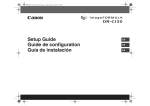
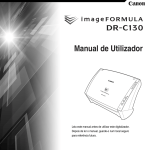
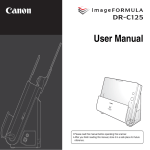

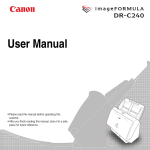
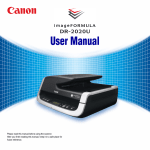



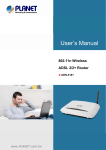
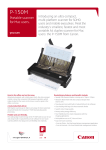
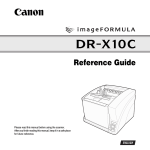

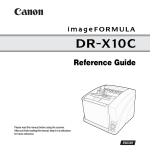
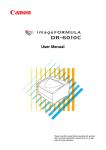
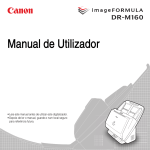
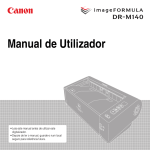
![Clique no botão Start [Iniciar]](http://vs1.manualzilla.com/store/data/006043720_1-9963bbea66c469e555d79ad614b31fbc-150x150.png)
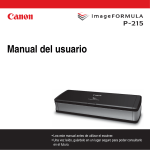
![Clique no botão Start [Iniciar]](http://vs1.manualzilla.com/store/data/006041791_1-478c128503a987820ff31ba94c46c492-150x150.png)
